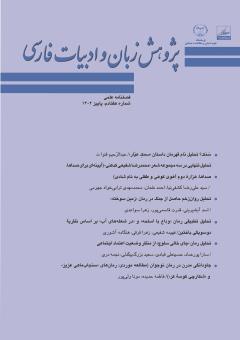تحلیل تطبیقی رمان «وداع با اسلحه» و «در شعلههای آب» بر اساس نظریۀ دوسویگی باختین
محورهای موضوعی : Research in Contemporary Iranian Literature
فهیمه شفیعی
1
![]() ,
زهرا قرقی
2
,
هنگامه آشوری
3
,
زهرا قرقی
2
,
هنگامه آشوری
3
1 - دانشجوی دکتری زبان و ادبیات فارسی، واحد تهران شمال، دانشگاه آزاد اسلامی، تهران، ایران
2 - استادیار گروه زبان و ادبیات فارسی، واحد تهران شمال، دانشگاه آزاد اسلامی، تهران، ایران
3 - استادیار گروه زبان و ادبیات فارسی، واحد تهران شمال، دانشگاه آزاد اسلامی، تهران، ایران
کلید واژه: گفتار دوسویه, چندصدایی, باختین, وداع با اسلحه و در شعلههای آب.,
چکیده مقاله :
دوسویگی، بخشی از نظریۀ چندصدایی «باختین» است که در آن صدای نویسنده به موازات صدای شخصیتها اهمیت دارد و با فنون مختلف در متن بازتاب مییابد. پژوهش حاضر که مبتنی بر روش توصیفی- تحلیلی است، دو رمان «وداع با اسلحه» نوشتۀ ارنست همینگوی و «در شعلههای آب» نوشتۀ مرتضی مردیها را به صورت تطبیقی تحلیل می¬کند. هدف از این پژوهش، پاسخ به این پرسش بنیادی است که دو نویسندۀ ایرانی و آمریکایی بر مبنای نظریۀ باختین از چه فنونی برای القای صدای خود در متن استفاده کردهاند. یافتههای پژوهش نشان میدهد که در بخش سبکبرداری، نویسندۀ هر دو رمان از فن نامگذاری شخصیتها، همسویی خود را با نیت شخصیتها نشان میدهند، با این تفاوت که شخصیتها در رمان «در شعلههای آب»، تیپیک هستند و شیوۀ نامگذاری آنها نیز بر همین اساس است. در بخش نقیضه در رمان «وداع با اسلحه»، گفتمان و رفتار شخصیت کاترین و همچنین صدای بیتفاوت راوی نسبت به جنگ، تداعیگر نوعی نقیضه است. در رمان «در شعلههای آب»، صدای بیتفاوت آهنج نسبت به جنگ سویه دیگر صدای مقدس و جدی جنگ است. گفتمان شفاهی در رمان «وداع با اسلحه» به صورت گفتمان ارتش و گفتمان مذهب و در رمان «در شعلههای آب»، گفتمان ستون پنجم، سپاه و ارتش بر متن احاطه دارند.
Dialogism, a key concept in Mikhail Bakhtin’s theory of polyphony, posits that the author's voice is parallel to the voices of the characters and is reflected in the text through various techniques.The current research, which is based on the descriptive-analytical method and based on library documents, compares the two novels "Farewell to Arms" written by Ernest Hemingway and "Dar SholehāyeĀb" written by MortezaMardiha.The purpose of this research is to explore the techniques employed by Iranian and American writers in the texts to convey their voices, as per Bakhtin's theory.The research findings reveal that both novelists although have some differences, they convey their intentions through character naming. In the novel "Dar SholehāyeĀb" the characters are archetypes and their names reflect this, while in "Farewell to Arms", the Catherine’s discourse and behavior, along with the narrator's indifferent attitude towards war, create a contrasting effect.In "Dar SholehāyeĀb", the indifferent voice of Ahanj conflicts with the sacred and serious voice of war. Military and religious discourse dominate the oral communication in "Farewell to Arms", whereas in "Dar SholehāyeĀb", the text is surrounded by the discourse of the fifth column, the Gurdian Corps, and the military. The hidden argumentative discourse in "Farewell to Arms" represents the voice of the military and religion, whereas in"Dar SholehāyeĀb", the voices of doubt and the military serve a similar purpose.
استادمحمدی، نوشین و دیگران (1396) «بررسی مصداقهای چندصدایی در رمان دکتر نون زنش را بیشتر از مصدق دوست دارد»، نشریۀ زبان و ادبیات فارسی، شماره 83، صص 23-42.
باختین، میخائیل (1384) زیباییشناسی و نظریۀ رمان، ترجمۀ آذین حسینزاده، تهران، مرکز تحقیقات و مطالعات هنری.
------------- (1396) تخیل مکالمهای جستارهایی دربارۀ رمان، ترجمۀ رؤیا پورآذر، چاپ پنجم، تهران، نی.
بازوند، فرشته (1402) مقایسۀ رمان وداع با اسلحه اثر ارنست همینگوی و زمستان 62 اثر اسماعیل فصیح در حوزۀ ادبیات جنگ و پایداری، پایاننامه کارشناسی¬ارشد، رشته زبان و ادبیات فارسی، به راهنمایی محمدرضا روزبه و علی نوری خاتونبانی، دانشگاه لرستان، دانشکدۀ ادبیات و علوم انسانی.
پاکدست، زهره و دیگران (1402) «مؤلفههای چندصدایی باختین در رمان درازنای شب اثر جمال میرصادقی»، نشریه علمی سبکشناسی نظم و نثر فارسی، دوره شانزدهم، شماره 83، صص 245-262.
پوینده، محمدجعفر (1377) درآمدی برجامعهشناسی ادبیات، تهران، نقش جهان.
تودورف، تزوتان (1396) منطق گفتگویی میخاییل باختین، ترجمۀ داریوش كریمی، چاپ چهارم، تهران، مرکز.
حضرتی، احسان و دیگران (1401) «بررسی تطبیقی شبکۀ مفهومی و عناصر روایی دو رمان ژانر جنگ، وداع با اسلحه اثر ارنست همینگوی و زمین سوخته اثر احمد محمود»، فصلنامۀ علمی و پژوهشی پژوهشهای ادبیات تطبیقی، دوره دهم، شماره 4، صص 79- 104.
رضی، احمد و محسن بتلاب اكبرآبادی (1389) «منطقالطیر عطار و منطق گفتوگویی»، متنپژوهی ادبی (زبان و ادب پارسی)، دوره چهاردهم، شماره 46، صص 19-36.
رفیعی، پریوش (1401) جلوههای ادب مقاومت در رمان در شعلههای آب اثر مرتضی مردیها، پایاننامه کارشناسی¬ارشد، رشته زبان و ادبیات فارسی، به راهنمایی بیژن ظهیری، دانشگاه محقق اردبیلی، دانشکدۀ ادبیات و علوم انسانی.
شیرشاهی، افسانه (1400) «تحلیل ساختار و محتوای رمان در شعلههای آب از مرتضی مردیها»، فصلنامۀ ادبیات دفاع مقدس دانشگاه شاهد، دوره پنجم، شماره 1، صص 145-166.
------------ (1402) «اندیشۀ وجودی در شعلههای آب از مرتضی مردیها»، کاوشنامه زبان و ادبیات فارسی، دوره بیست¬وچهارم، آمادۀ انتشارDOI: 10.
29252/KAVOSH.
2023.
19189.
3330.
.
غلامحسینزاده، غریبرضا و نگار غلام¬پور (1387) میخائیل باختین، زندگی، اندیشهها و مفاهیم بنیادین، تهران، روزگار.
مردیها، مرتضی (1378) در شعلههای آب، تهران، کویر.
مقدادی، بهرام و فرزاد یونانی (1382) «جویس و منطق مکالمه، رویکردی باختینی به اولیس جیمز جویس»، پژوهش زبانهای خارجی، شماره 15، صص 19-29.
مکاریک، ایرناریما (1398) دانشنامۀ نظریههای ادبی معاصر، ترجمۀ مهران مهاجر و محمد نبوی، تهران، آگه.
همتیپور، خدیجه (1397) بازتاب درونمایۀ عشق در رمان عشق سال¬های جنگ حسین فتاحی و وداع با اسلحه ارنست همینگوی، پایاننامه کارشناسی¬ارشد، رشته زبان و ادبیات فارسی، به راهنمایی محمدرضا حسنی جلیلیان، دانشگاه لرستان، دانشکده ادبیات و علوم انسانی.
همینگوی، ارنست (1400) وداع با اسلحه، ترجمۀ نجف دریابندری، چاپ نوزدهم، تهران، نیلوفر.
Emerson, Caryl (1997) The First Hundred Years of Mikhail Bakhtin, Princeton University Press.


